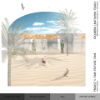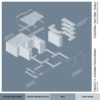Architectural Alchemy

Diagram showing termination of a repeating system.
The spring semester of 2020 for freshman architecture explored form in relation to the scale of the human body. This was done through examinations of scaled materials and the ways in which people interact with and sensorially respond to space. Students were encouraged to consider all construction scales as possessing the power to develop critical and influential architecture for those who interact with them.
Gallery
Students
Gavin Carroll, Diane Chen, Peter Fillion, Taib Iraqui, Fazel Kahn, Vicky Li, Jasmine Tarley
Faculty
Teaching Assistants
Anya Batista, Benjamin Ezquerra, Jenna Herbert, Michael Hoover, Morgan Mansfield, Stanicka Mathurin, Madeleine Niepceron, Abigail Peters, Austin Wyles, and Timothy Zeng.
Term
ARC 102
Spring 2020
Program
BS Arch
The studio focused on the process of designing for a full-scale built project. Students worked through the semester in teams to focus on elements of material, building, components, program, integration, teamwork, and representation. Students worked through a game-like design methodology that generated the parameters of the project – a single programmatic function and two materials. The student teams then worked together iteratively and collaboratively to develop a clear goal of a full scale-built work.
With the global shift of the COVID-19 pandemic, students began work in a new, digital way. The studio quickly pivoted away from the original goal of the full-scale built work, and continued to explore concepts of materiality and representation. Due to communication and technological changes, students proceeded more individually, maintaining group feedback within their critiques, but producing work on their own. From this, the course changed to allow students to advance technologically in how they approached thinking about materials, as well as methods of representation. In these methods, students produced a well-developed drawing each week for the remainder of the semester to continue thinking about the elements of material, building components, and program.
These weekly assignments allowed students to use their group project as a pivot point for their individual design focus. Students began to further develop their ideas on proportion and material sizes, system terminations, assembly, connections, and reflection. While students maintained the group dynamic through critique, the mid-semester shift allowed students to experiment with their individual interests. The studio teaching team leveraged Instagram as a forum for critique and cross-studio dialogue. Students posted their drawings to the first-year studio channel and commented on one another’s work. A curated sample of these posts was generated each week, and shared on the @ubuffaloarchplan Instagram feed to celebrate student work.






